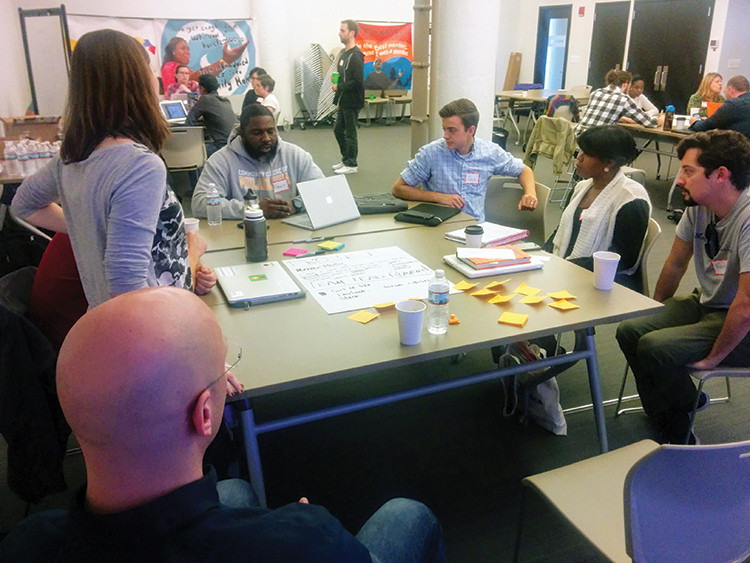Hackathon brings together parolees, technologists and journalists to create tech prototypes for the greater good
By Belinda Sharr
Reentering society after spending time in jail or prison can be challenging. Finding a job with a criminal record isn’t easy, and without money to purchase clothing and secure housing, it proves doubly challenging, as many employers require an address on an application. And then there’s reconnecting with family and finding support, which adds to the challenge.
Code for Philly (a community of civic technologists) and the Reentry Project (a collaboration of 15 newsrooms dedicated to solving issues of prisoner reentry) decided to meet this issue head-on—they hosted a “hackathon” event in October as an opportunity for journalists, technologists and reentering individuals to work together to create technology that will improve the lives of those reintegrating into society after paying their debt through a prison term. According to the Economy League, 44,000 Philadelphians return each year.
Robert Hudson was a hackathon attendee who has experienced the challenges of reentering the workforce. His team’s project, an app and website that connects mentors and mentees, was already in the works by the time the hackathon took place, and he continues to work on it to this day.
Hudson was affiliated with Code for Philly, which helped him start his project, Mentor Philly (visit mentorphilly.com or text 215.515.9696). The app can be used by people who are out of the system and looking for a mentor, and also for those who would like to mentor others.
“Mentors and mentees can use it to communicate without having to utilize traditional reentry services,” Hudson said. “The idea was modeled behind my progress and how I utilize my own mentors.”
According to Jean Friedman-Rudovsky, project editor for the Reentry Project, the idea for the event was conceived from a few different places—but namely it was created with the recognition that there is a desperate need for technological innovation in the reentry space.
After painstakingly laying the groundwork for the event, the hackathon culminated in a Friday night kickoff with about 50 people, and a Saturday team-building day. At the end, four impressive prototypes were debuted: Hudson’s mentor app; an SMS texting system to help people find Wi-Fi locations near them; a bilingual English and Spanish language website with resources on housing and employment; and a family needs assessment app that helps families create a profile of a returning family member along with a list of needs.
“I think the event turned out great—it far surpassed expectations, because we didn’t want to give people the impression that at the end you would come out with fully designed apps or websites,” Friedman-Rudovsky said. “Our goals were to bring together these different groups—journalists, those from the criminal justice system and technologists. I was pleasantly surprised to see the energy and enthusiasm that came out of it.”
“The collaboration was fantastic. One of the goals of the hackathon was to build a community and spaces for collaboration; and seeing this problem [of reentry] being met,” said Dawn McDougall, executive director of Code for Philly. “There was a spirit and energy at the event. That like-mindedness is going a long way.”
Hudson thought that the hackathon created a positive environment, and that it shed light on the issues surrounding the reentry process, as well as the stigma.
“I think [events like this] are a positive for folks coming home because it shows that traditional citizens are concerned about the issues in their community. For me, that’s the game changer—when you see people who are different interested in what you’re going through; they see people in their struggle and are interested in solutions,” he said. “The hackathon created a good opportunity for structure and support. It was about an issue in general: How do we support these guys and their road to redemption?”
_____
Four possible tech interventions for easing reentry after prison
1. SMS Text System: Halfway houses don’t allow smartphones or Wi-Fi, so the team created an SMS texting system where the user can text their location and receive information on where they can find spots with internet access. The service also offers assistance on locating food and shelter.
2. Bilingual Website with Assistance: The website features pages of resources for employment, housing and more. The team also created a text application allowing flip-phone users to text “1” for job assistance or “2” for housing help.
3. Family Profile Needs Assessment App: This prototype was created for families of people who will soon be released. They can go in and make a profile of their returning loved one and detail what they need help with in 18 categories. The needs assessment will allow the person and their family to have a clear understanding of challenges.
4. Mentoring App and Website: This app and website will connect people who need mentors with those who can help. It allows those who are released crucial access to people who can answer questions and guide them in starting their life again.







